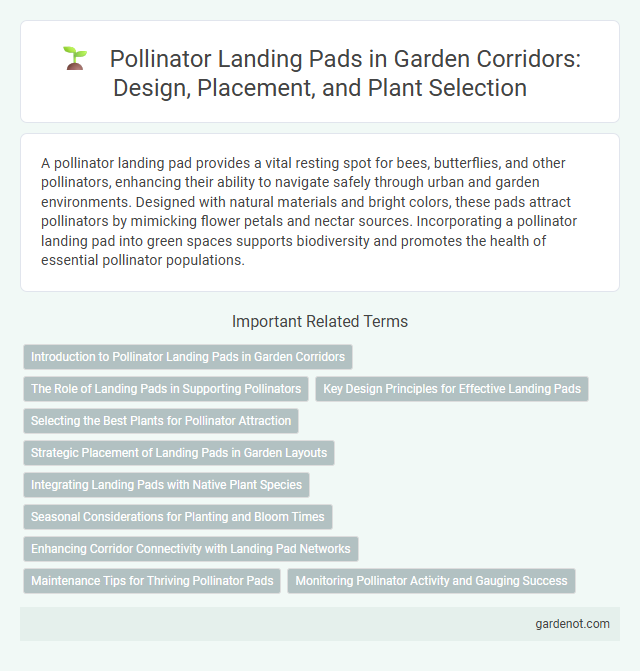A pollinator landing pad provides a vital resting spot for bees, butterflies, and other pollinators, enhancing their ability to navigate safely through urban and garden environments. Designed with natural materials and bright colors, these pads attract pollinators by mimicking flower petals and nectar sources. Incorporating a pollinator landing pad into green spaces supports biodiversity and promotes the health of essential pollinator populations.
Introduction to Pollinator Landing Pads in Garden Corridors
Pollinator landing pads create essential resting and feeding spots within garden corridors, enhancing habitat connectivity for bees, butterflies, and other pollinators. Designed with textured surfaces and strategically placed near nectar-rich flowers, these pads improve pollinator accessibility and foraging efficiency. Incorporating pollinator landing pads supports biodiversity by attracting a wide range of native pollinators crucial for ecosystem health and crop pollination.
The Role of Landing Pads in Supporting Pollinators
Pollinator landing pads provide essential resting and foraging sites for bees, butterflies, and other pollinators, enhancing their efficiency in nectar and pollen collection. These structures increase pollinator visitation rates by offering stable surfaces that facilitate access to flowers, improving plant-pollinator interactions. Integrating landing pads into pollinator corridors strengthens habitat connectivity and promotes biodiversity in agricultural and urban landscapes.
Key Design Principles for Effective Landing Pads
Effective pollinator landing pads incorporate natural materials like untreated wood or straw to facilitate safe and comfortable landings. The design includes perforations or textured surfaces to provide grip and prevent slipping for insects such as bees and butterflies. Proper orientation toward sunlight and incorporation of native plant elements enhance visibility and accessibility, promoting frequent pollinator visits.
Selecting the Best Plants for Pollinator Attraction
Selecting the best plants for pollinator attraction involves prioritizing native flowering species that provide abundant nectar and pollen throughout the growing season. Incorporating a diverse mix of shapes, colors, and bloom times enhances habitat suitability for bees, butterflies, and hummingbirds within pollinator corridors. Emphasizing plants like milkweed, coneflowers, and bee balm maximizes both pollinator visitation and corridor effectiveness.
Strategic Placement of Landing Pads in Garden Layouts
Strategic placement of pollinator landing pads in garden layouts significantly enhances pollination efficiency by offering easy access to nectar sources and resting spots. Positioning these pads near flowering clusters and along natural flight paths encourages increased visitation from bees, butterflies, and other pollinators. Incorporating a variety of native plants around landing pads further supports diverse pollinator species and promotes ecological balance.
Integrating Landing Pads with Native Plant Species
Integrating pollinator landing pads with native plant species enhances habitat connectivity by providing essential foraging and nesting sites that support local pollinator populations. Native plants offer the specific nectar and pollen resources that native pollinators rely on, optimizing pollination efficiency and biodiversity health. Strategically placed landing pads within native plant corridors create microhabitats that encourage pollinator visitation and facilitate successful plant reproduction across fragmented landscapes.
Seasonal Considerations for Planting and Bloom Times
Selecting appropriate native plants for a pollinator landing pad ensures continuous bloom throughout the growing season, supporting pollinators from early spring to late fall. Incorporating a diversity of flowering species with staggered bloom times maximizes nectar and pollen availability, critical for sustaining bees, butterflies, and other pollinators during seasonal shifts. Seasonal considerations also involve planting early bloomers like crocuses and late bloomers such as goldenrod to provide habitat connectivity within pollinator corridors year-round.
Enhancing Corridor Connectivity with Landing Pad Networks
Pollinator landing pads strategically placed within corridors create vital stopover points that facilitate seamless movement of bees, butterflies, and other pollinators between fragmented habitats. These networks increase floral resource availability and resting spots, thereby boosting pollinator foraging efficiency and promoting genetic diversity across plant populations. Integrating landing pads with native flowering species strengthens corridor connectivity, ensuring sustainable ecosystem services and biodiversity conservation.
Maintenance Tips for Thriving Pollinator Pads
Regularly remove weeds and dead plant material from pollinator landing pads to ensure healthy growth and reduce competition for resources. Water the area consistently during dry periods to maintain soil moisture without causing waterlogging, which can harm native plants and pollinators. Monitor for pests and diseases, using organic treatments when necessary to protect beneficial pollinator species and support biodiversity.
Monitoring Pollinator Activity and Gauging Success
Pollinator landing pads equipped with sensor technology enable precise monitoring of pollinator activity, capturing data on species frequency and visit duration. This information helps researchers gauge the success of pollinator corridors by tracking visitation patterns and identifying key pollinator species contributing to ecosystem health. Real-time data analytics facilitate adaptive management strategies, enhancing corridor design and promoting biodiversity conservation.
Pollinator landing pad Infographic

 gardenot.com
gardenot.com